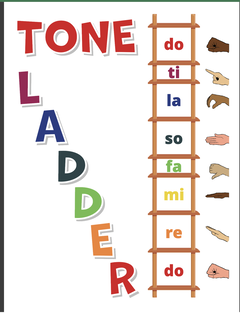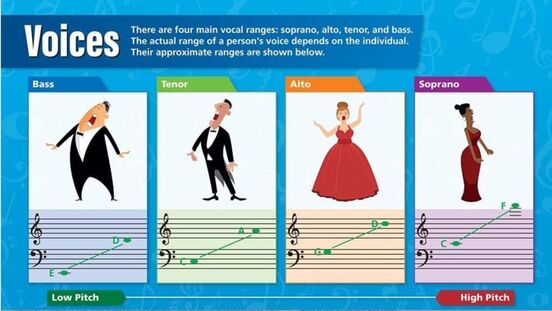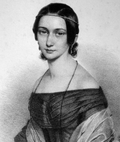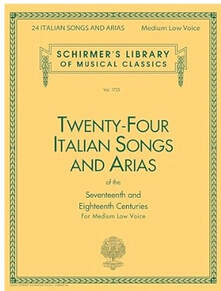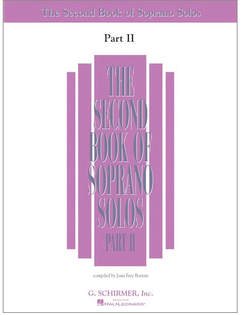Different Voice Types
SOPRANOS
Sopranos are characterized by impressive high notes (hence the name, which comes from the Italian “sopra” or “above”) and a timbre that usually sounds brighter or more sparkling than the other voice types. But don’t let the word “bright” fool you—sopranos are often capable of immense depth and richness of tone. In opera, sopranos are divided into three basic groups: coloratura (kuhl-er-ah-TOOR-ah), lyric, and dramatic, with coloratura being the lightest and most flexible sound, and dramatic being the darkest and most powerful. (“Lyric” lies more or less in the middle.) Sopranos often sing the melody or main tune of a piece while the other voices add support or “back-up” harmonies.
Who they are
Who they might play in an opera or a musical
Famous Examples
Sopranos are characterized by impressive high notes (hence the name, which comes from the Italian “sopra” or “above”) and a timbre that usually sounds brighter or more sparkling than the other voice types. But don’t let the word “bright” fool you—sopranos are often capable of immense depth and richness of tone. In opera, sopranos are divided into three basic groups: coloratura (kuhl-er-ah-TOOR-ah), lyric, and dramatic, with coloratura being the lightest and most flexible sound, and dramatic being the darkest and most powerful. (“Lyric” lies more or less in the middle.) Sopranos often sing the melody or main tune of a piece while the other voices add support or “back-up” harmonies.
Who they are
- Sopranos are usually women, but young boys may also fit into this category––their soft and airy tone works well in choir music. In addition, during the 17th and 18th centuries, Adjectives/colors/textures/tastes that can be used to describe them shimmering, shining, gleaming, bell-like, yellow, white, silvery, metallic, crystalline, silky, creamy
Who they might play in an opera or a musical
- romantic heroines (ingénues), young women, queens, princesses, angels
Famous Examples
- Maria Callas, Renée Fleming, Leontyne Price, Joan Sutherland, Kiri Te Kanawa, Dawn Upshaw, Sarah Brightman, Kristin Chenoweth, Judy Collins, Joni Mitchell (early recordings), Whitney Houston, Mariah Carey, Alison Krauss
MEZZO-SOPRANOS
Mezzo-sopranos get their name from the Italian prefix “mezzo,” meaning “half.” Although the category translates as “half-soprano,” there’s nothing “halfhearted” about the warm but sturdy voices that make up this group. In fact, mezzos often sing just as high as their soprano counterparts. In addition, operatic mezzos are also divided into the basic coloratura, lyric, and dramatic groups. What sets mezzos apart are their strong middle voices, their smoldering lower registers, and their lush tone quality. If a mezzo and a soprano were to sing the exact same pitch, the mezzo’s note would most likely sound a little bit fuller, darker, or heavier (imagine a clarinet playing the same note as a flute). Most female pop and Broadway artists fall into the mezzo category.
Who they are
Adjectives/colors/textures/tastes that can be used to describe them
Who they might play in an opera or a musical
Famous Examples
Mezzo-sopranos get their name from the Italian prefix “mezzo,” meaning “half.” Although the category translates as “half-soprano,” there’s nothing “halfhearted” about the warm but sturdy voices that make up this group. In fact, mezzos often sing just as high as their soprano counterparts. In addition, operatic mezzos are also divided into the basic coloratura, lyric, and dramatic groups. What sets mezzos apart are their strong middle voices, their smoldering lower registers, and their lush tone quality. If a mezzo and a soprano were to sing the exact same pitch, the mezzo’s note would most likely sound a little bit fuller, darker, or heavier (imagine a clarinet playing the same note as a flute). Most female pop and Broadway artists fall into the mezzo category.
Who they are
- Most mezzos are female with the exception of some male specialists known as countertenors who, much like their 17th- and 18th-century predecessors, train their vocal chords to approximate a female mezzo sound. Countertenors are usually only heard today in Baroque opera performances.
Adjectives/colors/textures/tastes that can be used to describe them
- dark, musky, glowing, fiery, golden, burgundy, coppery, smooth, velvety, chocolate-y
Who they might play in an opera or a musical
- seductive women, older women, queens, mothers, nurses, witches, young men (these roles are known as “pants roles” and often occur in opera)
Famous Examples
- Agnes Baltsa, Olga Borodina, Tatiana Troyanos, Shirley Verrett, Frederica von Stade, Judy Garland, Audra McDonald, Beyoncé, Lea Michele, Celine Dion, Christina Aguilera, Lady Gaga
ALTOS or CONTRALTOS
And you thought the mezzos had deep voices? Check these ladies out. Contraltos are arguably the rarest of female voice types, and they possess a tone so dark they often give the men a run for their money. If mezzos are like clarinets, contraltos are more like bass clarinets. The lower register is the key feature of this category, and contraltos know better than anyone how to make the most of their low “chest” tones. This doesn’t mean contraltos skimp on the high notes, though––operas often feature a coloratura contralto that can reach pretty far up into the vocal stratosphere with lightning speed. Contralto voices play a big part in jazz and pop music, however, and you’re probably more likely to hear a contralto on the radio or in a cabaret setting than on the operatic stage.
Who they are
Adjectives/colors/textures/tastes that can be used to describe them
Who they might play in an opera or a musical
And you thought the mezzos had deep voices? Check these ladies out. Contraltos are arguably the rarest of female voice types, and they possess a tone so dark they often give the men a run for their money. If mezzos are like clarinets, contraltos are more like bass clarinets. The lower register is the key feature of this category, and contraltos know better than anyone how to make the most of their low “chest” tones. This doesn’t mean contraltos skimp on the high notes, though––operas often feature a coloratura contralto that can reach pretty far up into the vocal stratosphere with lightning speed. Contralto voices play a big part in jazz and pop music, however, and you’re probably more likely to hear a contralto on the radio or in a cabaret setting than on the operatic stage.
Who they are
- Females
Adjectives/colors/textures/tastes that can be used to describe them
- heavy, strong, bronze, purple, smoky, husky, rich, dark chocolate-y
Who they might play in an opera or a musical
- mothers, grandmothers, earth goddesses, witches, nuns or priestesses, military generals (a sort of 18th century mega-pants role)
- Elena Obraztsova, Marian Anderson, Ella Fitzgerald, Tracy Chapman, Cher, Annie Lennox, Toni Braxton
Tenors
Tenors are the highest male voice and, like sopranos, they are capable of delivering thrilling high notes and often have a brilliant shining timbre. Think of them as the trumpet of the vocal orchestra. These singers get their name from the Italian “tenere,” which means “to hold” because, in very early music, it was their job to hold down the melody and drive the song. This often remains true in today’s music, as many of the lead singers in pop groups and rock bands are tenors. In opera, tenors have several subcategories, which range from the softer sound of the tenore buffo (ten-OR-eh BOO-foh, a high-range tenor who sings comedic roles) to the bold and hefty sound of a Heldentenor (HELL-dehn-ten-OR, the term for a strong-voiced tenor who sings heroic roles in lengthy German operas).
Who they are
Adjectives/colors/textures/tastes that can be used to describe them
Who they might play in an opera or a musical
Famous examples
Who they are
- Mature males. It’s important to note that, although they sing some pretty high notes, tenors are different from young boys whose voices haven’t changed yet. As singing expert Richard Miller puts it, a tenor voice is a full and energetic adult sound.
Adjectives/colors/textures/tastes that can be used to describe them
- bright, dazzling, clear, brassy, ringing, sunny, yellow, orange, metallic, tinny, juicy, spicy
Who they might play in an opera or a musical
- leading men, romantic heroes, young boys, princes, knights, soldiers
Famous examples
- José Carreras, Enrico Caruso, Franco Corelli, Luciano Pavarotti, Juan Diego Flórez, Paul McCartney, Chris Martin (lead singer of Coldplay), Justin Timberlake
Baritones
The most common of all male voices, this category occupies the wide range of vocal timbres between the tenor and the bass. Interestingly, this voice type wasn’t officially acknowledged until the 19th century when, as Miller puts it, composers caught wise to the fact that using vocal variety and “contrast” made for much more exciting music than simply dividing parts between the guys who could sing high and the guys who could sing low. As a result, the baritone voice, recognizable by its glorious middle register, came into fashion and was championed in many 19th-century operas, particularly those of Verdi.
As with all other categories, the baritone comes in many forms, including the lyric (a lighter voice often featured on the classical concert stage) and the dramatic (a darker tone used in lead operatic roles). In contemporary music, baritones are more likely to show up in the country western and R&B genres than in pop or rock ballads, which tend to favor tenor voices.
Who they are
- Males
Adjectives/colors/textures/tastes that can be used to describe them
- smooth, warm, brown, tan, velvety, lush, plush, rich, coffee-like
Who they might play in an opera or a musical
- the tenor’s rival for the soprano, seductive men, the tenor’s best friend, husbands, older heroes, fathers
Famous examples
- Norm Lewis, Thomas Hampson, Dmitri Hvorostovsky, Sherrill Milnes, Leonard Warren, Toby Keith, Brian Stokes Mitchell, Frank Sinatra, Harry Connick Jr., Luther Vandross
The Basics of Bel Canto
Soprano Literature
|
SAMUEL BARBER'S "SURE ON THIS SHINING NIGHT": EXAMPLE
|
"SURE ON THIS SHINING NIGHT": ACCOMP.
|
9 Tone ScalesHum |
Balanced OnsetDo to So Tongue |
CONTACT
BRYAN BRINKMANN-THOMPSON
[email protected]
913.980.7450
GREEN SPRINGS ELEMENTARY SCHOOL
14675 S. ALDEN STREET
OLATHE, KS 66062
BRYAN BRINKMANN-THOMPSON
[email protected]
913.980.7450
GREEN SPRINGS ELEMENTARY SCHOOL
14675 S. ALDEN STREET
OLATHE, KS 66062
